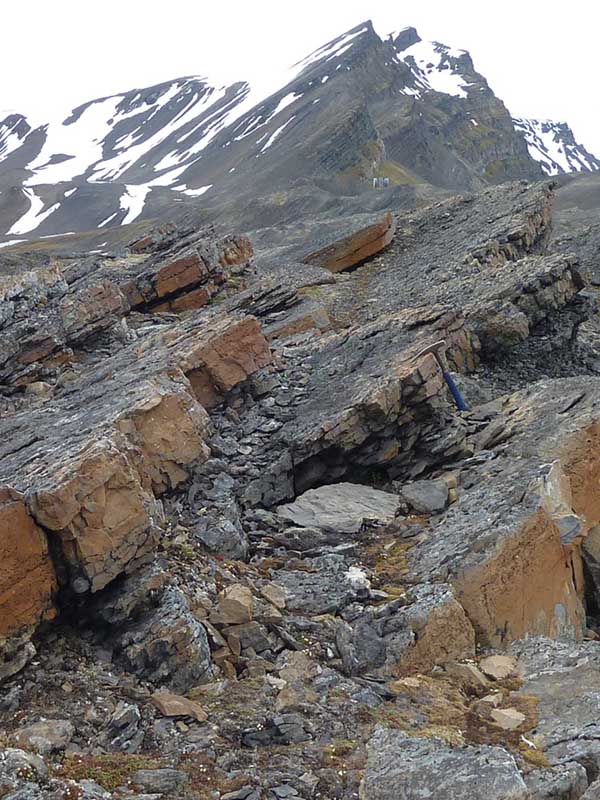
by Julie Freydlin Monday, July 13, 2015

The Kapp Starostin Formation on Norway's Spitsbergen Island holds clues to a mass extinction event roughly 262 million years ago in the Middle Permian. Credit: Dierk Blomeier
Since the explosion of complex lifeforms before the turn of the Cambrian, the expansion of life on Earth has been punctuated by a quintet of global mass extinctions known as the “Big Five.” The biggest of these happened toward the end of the Permian Period about 252 million years ago, when 95 percent of all species went extinct. In a new study, scientists have proposed that a sixth global extinction, about 10 million years before the End-Permian die-off, should be added to the list.
Evidence for an extinction during the Capitanian Age of the Middle Permian, has previously been found in South China. There, the fossil record from the time indicates that 87 percent of brachiopod species — a group of shelled marine invertebrates comprising only a few hundred species today, but which were far more diverse in the Permian — disappeared. Whether the extinction extended globally, however, has long been unclear.
South China was tropical during the Capitanian. It “was pretty much right on the equator,” says David Bond, a geologist at the University of Hull in England and lead author of the new study, published in the Geological Society of America Bulletin. Looking to see if marine animals elsewhere in the world had been affected at the same time, he and his colleagues studied a sequence of chert and limestone layers on the Norwegian island of Spitsbergen known as the Kapp Starostin Formation.
Sitting well above the Arctic Circle today, the Kapp Starostin — exposed along a string of cliffs hundreds of meters long, and in some places, hundreds of meters high — formed under water at midlatitudes during the Permian. Bond and his team analyzed brachiopod assemblages in the rock and found that, above a limestone layer dating to about 262 million years ago, the diversity of brachiopod species plummeted rapidly. In fact, 87 percent of the brachiopod species present beneath the layer disappeared within tens of centimeters above it, matching the decline observed in South China. Other groups of organisms suffered losses at the time as well, Bond says, noting that his team focused on brachiopods because they were “the most abundant and diverse group in Spitsbergen at that time.”
Besides marking the disappearance of species, the Capitanian was also a time of major volcanic eruptions. Ash from southwestern China’s Emeishan Traps, for example, dates to the Capitanian and has previously been implicated as a potential cause of the local brachiopod extinction. It’s possible “that increased atmospheric carbon dioxide [from volcanic eruptions] led to ocean acidification,” Bond says. And this could be why both limestone and brachiopods disappear within a short interval in the Kapp Starostin, although he says it’s uncertain yet whether the eruptions and the extinction happened simultaneously.
The extinction at Spitsbergen does appear to coincide with signs of oxygen depletion at the time. To assess this, Bond and his colleagues measured the size of pyrite framboids in the Kapp Starostin Formation. “These are tiny little blobs of pyrite, and their size, especially when small, is indicative of whether or not you have an anoxic water column,” Bond explains. Anoxia would have resulted from a rise in temperature caused by elevated levels of heat-trapping carbon dioxide in the atmosphere, as oxygen doesn’t dissolve as well in warm water. Brachiopods, which need oxygen, could have succumbed under such conditions. Also, volcanic eruptions would have released high doses of toxic elements like mercury, another hazard for brachiopods.
Two of Bond’s co-authors on the new study, Benoit Beauchamp and Stephen Grasby of the University of Calgary, have early findings suggesting another northern region, the Sverdrup Basin of Arctic Canada, experienced the same rate of brachiopod extinction at the same time as seen at Spitsbergen. In the Sverdrup, too, the presence of carbon dioxide seems to have caused acidification of oceans and the disappearance of carbonate rock. Bond says he hopes that his team’s ongoing field work in the region will provide more evidence for the extinction.
Michael Benton, a paleontologist at the University of Bristol, says the new findings are significant because they reshape scientists’ understanding of past major extinctions. “The new work from Spitsbergen, coupled with comparisons with Greenland and Arctic Canada, suggest a northern Boreal extinction at the same time, and of similar magnitude,” to that previously recognized in equatorial regions, he says. Because the Capitanian Extinction seems to traverse across continents and climate zones, Benton says, it could be a candidate for expanding the “Big Five” into the “Big Six.”
© 2008-2021. All rights reserved. Any copying, redistribution or retransmission of any of the contents of this service without the expressed written permission of the American Geosciences Institute is expressly prohibited. Click here for all copyright requests.